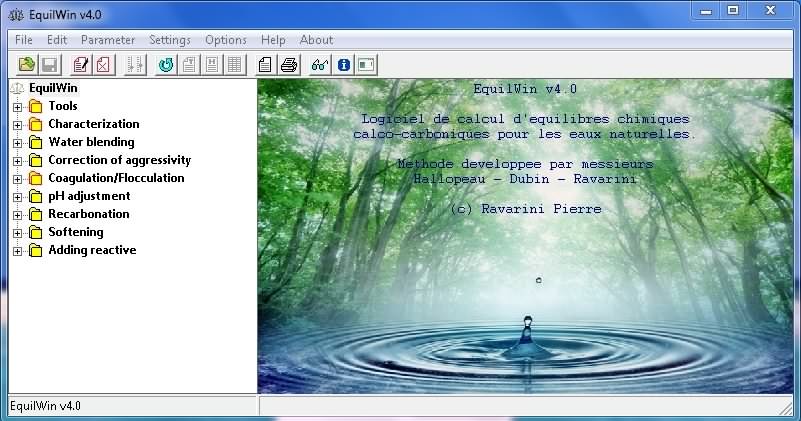
Preamble.
This software is a calculation program, according to known and
tested method in water treatment speciality : HALLOPEAU & DUBIN
method, to modify, supplement and implement by the author
(Software Protection : Act 92-597 of 1 July 1992 on
the Intellectual Property Code).
(contact the author for a price quot - not
downloadable software).
See : J. Hallopeau - " Les équilibres carboniques dans les
eaux " - Terres et Eaux, 1960/1961.
All formulations are explainable : thermodynamic laws, equilibrium
equations, acido-basic reactions, etc.
Proposed option are according as study and treatment of natural
waters.
And also, it test by many usage : laboratory studies or "in the
field" (treatment station for drinking water and industrial waters),
including automatic tryouts.
For calculations with iteration procedure, it use dichotomic method,
which to allow more fastness to good accuracy : mathematic feedback
value = from 0.01 to 0.1 according to events.
- EQUILWIN is a software coded to run under Windows. No problem using interfaces WINDOWS 7 to 10 (32/ 64 bits).

Please Note - Equil v5/v6, old version was developed
with Quick Basic V4.5, and thus, is a software running under DOS
command prompt (Windows <Vista).
Mouse is not usable : most actions are controlled by the keyboard key
presses (numbers or letters).
So, majority of actions are ordered with keyboard, by presses on keys
(figures or letters).
Very often it should be noted that the required answer Y(es), and key
"Enter", are equivalent.
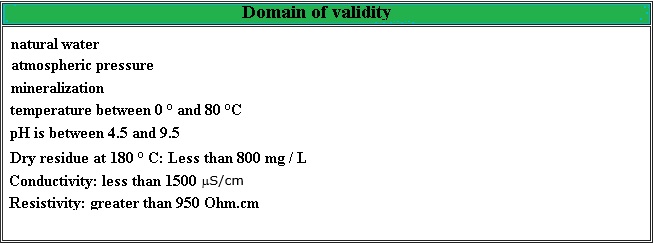
The pressure is close to atmospheric pressure.
With regard to calculation of pH, program account of an acidity which
holds can be noncarbonic (sulphuric, hydrochloric, etc) and in this
case, uses formulas of pKa.
In principle, EQUILWIN program announces all excessive introduced or
calculated values, and, in majority of cases, continuation of
calculations is allowed.
The majority of water treatments are available and allows to
simulate the chemical action in ionic equilibrium such as
calcium/carbonates/CO2 balance.
Only five parameters are needful for current
calculations :
Temperature, pH, alcalinity, calcium and dry
residue (else conductivity or resistivity).
Initial reference is requested, but this is optional.
NB. Equilwin for : registration of each water or session (persistent
or not).
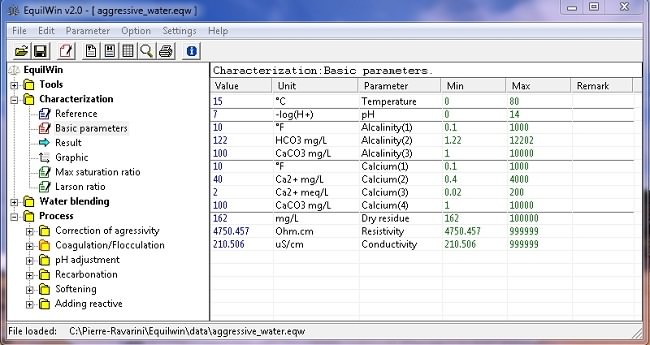
Note : CCPP (calcium carbonate precipitation/dissolution
potential) : defines the mass of CaCO3 to be (theorically) precipited
from, or dissolved into, a water to attain saturation with respect to
CaCO3.
In this last case (dissolved), CCPP has a negative value.
On the other hand, tendancy direction of water is indicated :
aggressive, scaling or in equilibrium (balance) ; and also
proposition of correction (stabilization / recarbonation).
Equilwin example (agressive water) :
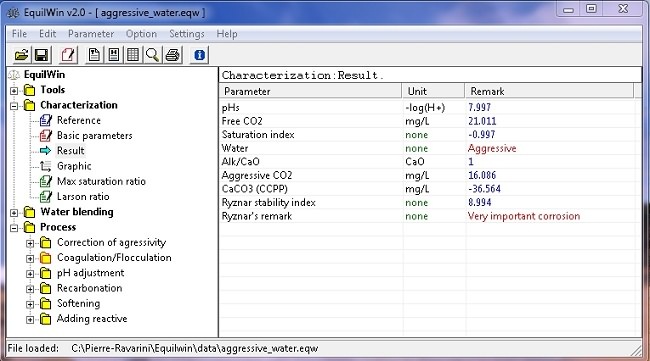
Next these results, potential choices :
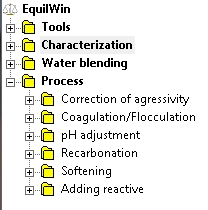
Some choices according as water treatments, but are used, only to
simulate action on calcium-carbonic equilibrium.
Note : for the majority of proposed chemicals, demand input of purity
input (pure product amount) in %.
Example (Equilwin picture) :
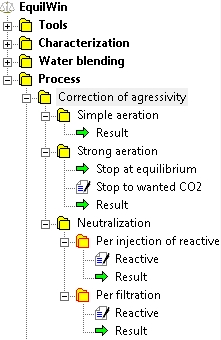
In addition, for all reagents the purity (% of pure product) can
be introduced (optional).
Flocculation (coagulation)
:
Allows to simulate coagulation (process of agglomeration
and precipitation of particles).
Can test itself by action to introduce of coagulant reagent (6
products).

Note : proposed menus allow,
- either to continue to treat water,
- or to change amount (without changing coagulant),
Please, note that values of increase in some elements (not
introduce at beginning) are announced: sulphates and/or
chlorides.
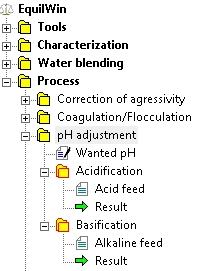
The pH decreasing (acidification), if that's possible, (control by program), can be carried out by 6 reagents :
Also, 4 basic reagents are proposed :
And, for all reagents, purity (pure product %) can be introduced
(optional).
It should be noted that values of increase in some elements
(not introduce at beginning) are announced:
sulphate, chloride or sodium.
Equilwin example (wanted pH : 7.5, lime as 80% of purety) :
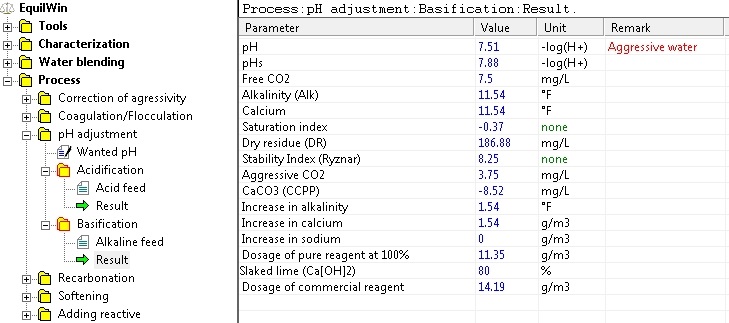
Recarbonation :
Allows to increase bicarbonated-calcic mineralization.
(should the occasion, until equilibrium pH [pHeq]
EquilWin test recarbonation by action of :
Note : calculation stop is with wanted alkalinity, and/or with alkalinity AND pH value if lime used).
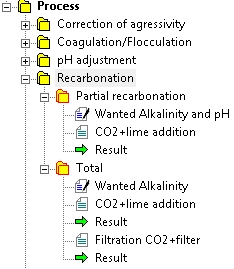
Softening:
Allows to reduce bicarbonated-calcic species or
calcium.
(three options, after introduction of desired calcium value)
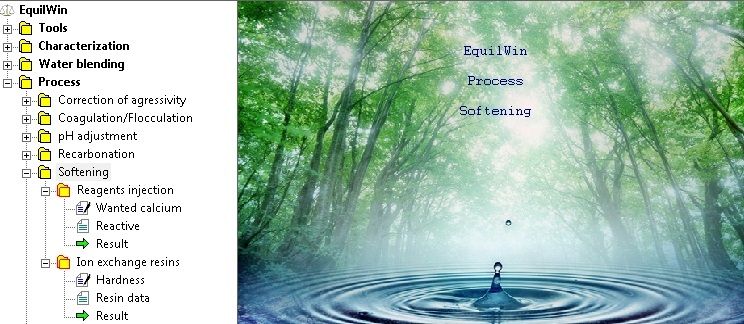
Is therefore :
- Use of alkaline reagent :
- lime,
- caustic soda.
- Ions exchange resins (input of Total Hardness or magnesium),
sodium.
Remark : this program is not a dimensioning software for
device and ion exchange product, it's just one approach of resin
volumes to use (cationic resin), and water to be treated (calculation
of by-pass).
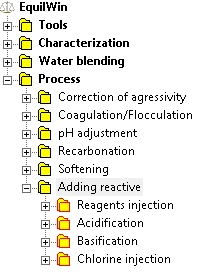
Is therefore : 4 tasks,
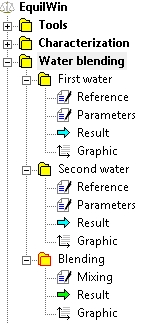
Notes:
. we can test the mixture of initial water in memory (or registered
Equilwin water), with a second water, which we introduce the five
essential parameters.
Also, a graph is drawn, also we can determine the final condition of
a water after blending several waters for variant fractions.
Values expressed in mol/liter.
This calculation is carried out on the water in characterization
(currently).

Pierre Ravarini - August 2015.